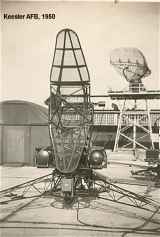AN/TPS-10
Description of the radar set, tactical-technical characteristics
 Hersteller:
Hersteller:MIT's Radiation Laboratory,
Radio Corporation of America
| Specifications | |
|---|---|
| frequency: | 9 230 to 9 404 MHz |
| pulse repetition time (PRT): | |
| pulse repetition frequency (PRF): | 539 Hz |
| pulsewidth (τ): | 0.5 and 2 µsec |
| receive time: | |
| dead time: | |
| peak power: | 250 kW |
| average power: | |
| instrumented range: | 60/120 NM (≙ 110/220 km) |
| range resolution: | |
| accuracy: | |
| beamwidth: | |
| hits per scan: | |
| antenna rotation: | |
| MTBCF: | |
| MTTR: | |
AN/TPS-10
The AN/TPS-10 was an X-Band nodding height-finding radar. The transmitter/receiver electronic was essentially a stripped down version of the AN/CPS-6B. The transmitter used a magnetron of type 6002/QK221. The display was an RHI-scope with a cathode-ray tube of 12" diameter.
MIT's Radiation Laboratory developed and produced the first version of this radar near the end of World War II. Zenith produced the A-model sets in the post-war period. The vertically mounted antenna was three feet wide and ten feet long. Two operators were needed to run the set. The initial model operated at a frequency of 9 000 to 9 160 MHz and had a maximum reliable range for bombers of 60 miles at 10 000 feet.
AN/FPS-4 and AN/MPS-8
An updated version designated the AN/FPS-4 was produced by the Radio Corporation of America (RCA) beginning in 1948. Some 450 copies of this and the trailer-mounted AN/MPS-8 version were built between 1948 and 1955.

